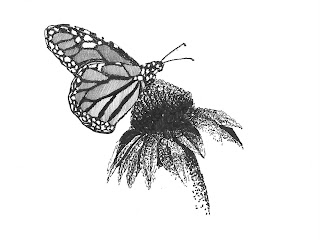Happy Solstice!
Even though it occurred at 8:26 this morning...Happy Solstice! YAY first day of summer and longest day of the year! Well, actually, it's still 24 hours, but the most hours of sunlight. There's a little melancholy though, cause from here on out, the days get shorter. Next thing you know, we'll be turning the clocks back. Bah. The thing I like best about this time of year is twilight. It's really long now, longer than any other time of year. Last night the sunset was really colorful, full of pinks and oranges, so twilight had this rosy glow for quite awhile. We counted three bats and watched the lightening bugs rise up from the grass down in the corner of the yard. Flowers supposedly smell their strongest at twilight, which I've known to be true with the fragrant ones I have. The French refer to this time of day as l'heure bleue or the blue hour. The Scotts refer to it as the gloaming, which is terribly romantic for some reason but not really a word that you can work into casual conversation without appearing pretentious. "Shall we retire to the back lawn to take in the gloaming?" See what I mean?
The definition of evening twilight (because there is a morning twilight) is that period after sunset when the sun is less than 6 degrees below the horizon. Sometimes this is also referred to as civil twilight, because it has been used in law. Civil twilight is when you need to turn on your headlights or makes the difference if you are charged for a daytime burglary or a nightime burglary (according to Wikipedia). After civil twilight comes dusk, when the sun is 6 degrees below the horizon. There is little to no light and things are no longer recognizable. Then comes nautical twilight, when the sun is more than 6 degrees but less than 12 degrees below the horizon and the point at which sailors can see to navigate using celestial bodies. Astronomical twilight is last, when the sun is more that 12 degrees below the horizon. Very faint stars are visible now. The faintest stars visible to the naked eye appear when the sun is 18 degrees below the horizon. So tonight, after dinner, wander outside and enjoy the longest twilight of the year, cause from here on out, it'll just keep getting shorter.
Oh, one more fun fact. You know how things active in the day are diurnal? And during the night is referred to a nocturnal? Well guess what things active during twilight are called? Crepuscular! Where the hell did that come from? Not a pretty word. Ok, all for now. Later.
The definition of evening twilight (because there is a morning twilight) is that period after sunset when the sun is less than 6 degrees below the horizon. Sometimes this is also referred to as civil twilight, because it has been used in law. Civil twilight is when you need to turn on your headlights or makes the difference if you are charged for a daytime burglary or a nightime burglary (according to Wikipedia). After civil twilight comes dusk, when the sun is 6 degrees below the horizon. There is little to no light and things are no longer recognizable. Then comes nautical twilight, when the sun is more than 6 degrees but less than 12 degrees below the horizon and the point at which sailors can see to navigate using celestial bodies. Astronomical twilight is last, when the sun is more that 12 degrees below the horizon. Very faint stars are visible now. The faintest stars visible to the naked eye appear when the sun is 18 degrees below the horizon. So tonight, after dinner, wander outside and enjoy the longest twilight of the year, cause from here on out, it'll just keep getting shorter.
Oh, one more fun fact. You know how things active in the day are diurnal? And during the night is referred to a nocturnal? Well guess what things active during twilight are called? Crepuscular! Where the hell did that come from? Not a pretty word. Ok, all for now. Later.


4 Comments:
Back in my teaching days I gave crepuscular as a bonus question -- I had mentioned the term briefly during one of my lectures that week. Several students surprised me by correctly defining the term.
And Happy Solstice to you, too.
Happy Solstice! I learn so much here... gloaming, crepuscular... Maybe I'll go out and sound pretentious today. ;)
Once you hear the word crepuscular, it would be hard to forget, although it does sound like some kind of medical term, doesn't it? "The xrays show a blockage in the upper crepuscular". I'm glad I'm learnin' ya Liz. New words are fun, especially trying to work them into your vocabulary.
It was definitely a happy solstice for me. I was out at 6:30 a.m., as usual, letting out the chickens and ducks and working in the garden, and muttering, "Man, if I have to get up any earlier..."
And then I realized I never would have to get up any earlier. :-)
Post a Comment
<< Home